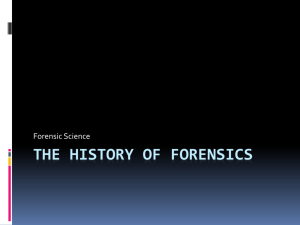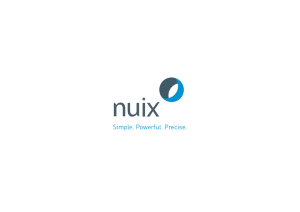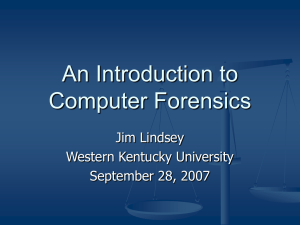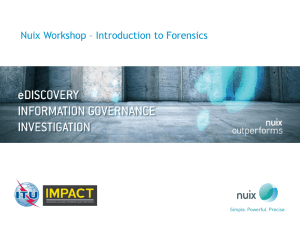Document 12953172
advertisement
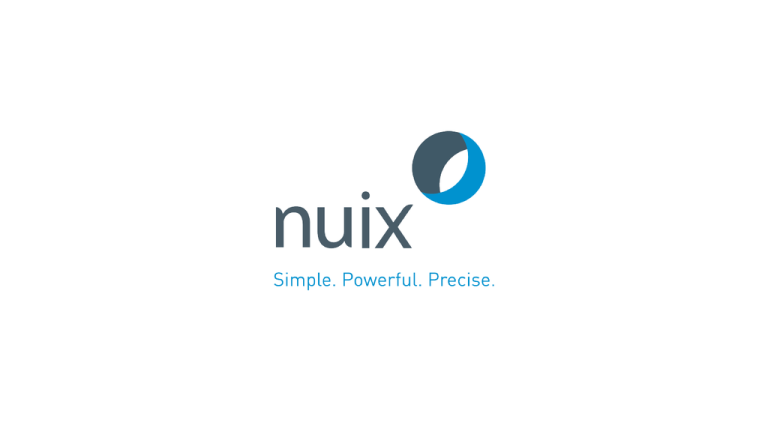
Nuix Workshop – Introduction to
Digital Forensics
WHAT
IS
COMPUTER/DIGITAL FORENSICS?
•
Computer forensics, also called cyber forensics, is the application of scientific method to computer investigation
and analysis in order to gather evidence suitable for presentation in a court of law or legal body. The goal of
computer forensics is to perform a structured investigation while maintaining a documented chain of evidence to
find out exactly what happened on a computer and who was responsible for it.
•
Computer forensics has become its own area of scientific expertise, with accompanying coursework and
certification.
•
Informática forense, también llamados los forenses cibernéticos, es la aplicación del método científico a la
investigación y análisis de la computadora con el fin de reunir las pruebas adecuadas para su presentación en
un tribunal de justicia o cuerpo legal. El objetivo de la informática forense es llevar a cabo una investigación
estructurada, manteniendo una cadena de evidencia documentada para averiguar exactamente lo que sucedió
en un equipo y que era responsable de la misma.
•
Informática forense se ha convertido en su propia área de conocimientos científicos, con el acompañamiento de
los cursos y la certificación.
September 14, 2014
COPYRIGHT NUIX 2014
3
SCIENTIFIC METHOD?
The Scien)fic Method •
•
The scientific method is a recognised body of
techniques for investigating incident or
occurrence, acquiring new knowledge, or
correcting and integrating previous knowledge.
To be termed scientific, a method of enquiry
must be based on empirical and measurable
evidence subject to specific principles of
reasoning.
Scientific method is a model applied to all
areas of scientific examination. These elements
are valuable to computer forensic science
Ask a Question
Do background
research
Construct
hypothesis / theory
Investigate
through analysis
Draw conclusion
prove hypothesis
Report your
results
September 14, 2014
COPYRIGHT NUIX 2014
4
Industry Guidelines
Principle 1: No action taken by law enforcement agencies or their agents should change data held on a computer or storage media which may subsequently
be relied upon in court.
Principle 2: In circumstances where a person finds it necessary to access original data held on a computer or on storage media, that person must be
competent to do so and be able to give evidence explaining the relevance and the implications of their actions.
Principle 3: An audit trail or other record of all processes applied to computer-based electronic evidence should be created and preserved. An independent
third party should be able to examine those processes and achieve the same result.
Principle 4: The person in charge of the investigation (the case officer) has overall responsibility for ensuring that the law and these principles are adhered to.
Principio 1: Ninguna acción tomada por las fuerzas del orden o de sus agentes debe cambiar los datos almacenados en un soporte informático o de
almacenamiento que posteriormente pueda ser invocada ante los tribunales.
Principio 2: En circunstancias en que una persona se ve obligado a acceder a los datos originales guardados en un ordenador o en medios de
almacenamiento, esa persona debe ser competente para ello y ser capaz de prestar declaración explicando la importancia y las implicaciones de sus
acciones.
Principio 3: Una pista de auditoría u otro registro de todos los procesos que se aplican a las pruebas electrónicas por computadora deben ser creados y
preservados. Un tercero independiente debe ser capaz de examinar los procesos y obtener el mismo resultado.
Principio 4: La persona a cargo de la investigación (el oficial de caso) tiene la responsabilidad general de garantizar que las leyes y estos principios se
cumplen.
Source http://www.acpo.police.uk/documents/crime/2011/201103CRIECI14.pdf
September 14, 2014
COPYRIGHT NUIX 2014
5
The Forensic Approach
The benefits of the application of digital forensics to computer based investigations underpin the following:
•
•
•
•
•
•
Security of evidence / incident
Integrity of investigative steps
Deeper analysis unallocated space / file slack (The whole story)
Auditable response
Repeatability of action
Best evidence practice
September 14, 2014
COPYRIGHT NUIX 2014
6
MANAGING SECURITY INCIDENT?
SECURITY OPERATIONS NETWORK OPERATIONS September 14, 2014
COPYRIGHT NUIX 2014
7
EVIDENCE
HANDLING
&
CHAIN OF CUSTODY
•
The first step in any investigation is the search & seizure of exhibits which may contain crucial evidence!
•
Decisions that you, make may result in loss of crucial evidence.
•
Points to consider
• DNA and/or fingerprints
• Prevent tampering & preserve original condition
• Record details & actions – paperwork!
• Store in a secure location
• What is capable of storing data?
• Losing data – shutdown or not?
September 14, 2014
COPYRIGHT NUIX 2014
8
Doing nothing even causes changes
•
Even at rest a computer is using
memory and performing disk writes.
This is essential to the operating
system.
•
The capture shows disk activity on a
computer with no user activity and
no applications running.
•
•
•
•
Now consider
Malware
Anti forensic applications
Cluster overwrites
September 14, 2014
COPYRIGHT NUIX 2014
9
COLLECTING
DATA
–
FORENSIC METHOD
•
Whether we are considering logical or physical collection we must ensure that we collect data in
accordance to industry guidelines and take every step to protect the data from any change due to our
action. In accordance to guidelines if this is impractical we must ensure we understand the implications
of our actions.
•
A write blocker is a hardware or software device that prevents ANY write activity to a connected device
or resource. We can then use a forensic application or DD command to collect the data into a forensic
container.
September 14, 2014
COPYRIGHT NUIX 2014
10
FORENSIC IMAGE FILES
SJC4-­‐SIM1 SJC4 SJC1 SJC2-­‐DISC001 SJC1-­‐HD1 •
•
•
Forensic image files are generated with specialist tools
Are an exact ‘bit for bit’ acquisition of the data
All devices should be unique referenced
SJC3-­‐FD001 SJC3-­‐FD002 SJC3-­‐FD003 Write Blocker September 14, 2014
Inves)gator COPYRIGHT NUIX 2014
SJC5 Suspect Drive 11
FORENSIC IMAGE -
CONTAINER
• Data is collected from the source device at binary/disk level by pre defined size and
each section is checked with a CRC checksum. The whole image is then verified
with an MD5 checksum
1010101010101010100101010101010101010101010010101010101010010101010101111010101010101010101010101010101010000000 Header Case informa<on 101010110101010
010101010100100
101010101001001
010101010101010
010101010101010
101010001010101
010101010101010
101010101010101 C R C 101010110101010
010101010100100
101010101001001
010101010101010
010101010101010
101010001010101
010101010101010
101010101010101 C R C 101010110101010
010101010100100
101010101001001
010101010101010
010101010101010
101010001010101
010101010101010
101010101010101 C R C 101010110101010
010101010100100
101010101001001
010101010101010
010101010101010
101010001010101
010101010101010
101010101010101 C R C M
D 5 • Should any single value be change then the CRC would fail and the MD5
checksum would present a different value. Therefore verification would fail and the
collection process would be undermined.
September 14, 2014
COPYRIGHT NUIX 2014
12
MD5 –
CREATING INTEGRITY
• MD5 is an algorithm that is used to verify data integrity through the creation of a
128-bit message digest from data input (which may be a message of any length).
The result is as unique to that specific data as a fingerprint is to the specific
individual. Input MD5 Algorithm MD5 Checksum Name MD5 Hash Func<on 6969 1c7b dcc3 ce6d 5d8a 1361 f22d 04ac My Name MD5 Hash Func<on 23be cb09 3bdd d87e 817e dfa1 7962 f9e8 My Name is Nuix MD5 Hash Func<on 877e 569d b075 2088 4c36 df51 8337 5780 Iden<cal data will provide iden<cal MD5 September 14, 2014
COPYRIGHT NUIX 2014
13
Investigations – An Intelligent approach
•
•
•
Investigations frequently involve large numbers of devices including multiple computers, mobile devices
and a variety of digital storage media.
Traditional methods of analysing each data repository individually are immensely time consuming and
often ineffective.
Typical collection of devices for investigation analysis
Ø
Ø
Ø
Ø
Ø
Ø
Ø
Ø
Ø
•
•
Suspect’s personal possessions
Apple Mac book Laptop (HFS+)
Apple iPhone (iOS)
External Hard Drive
Company/Employer data relating to suspect
Microsoft Windows Desktop PC
Microsoft Exchange Mailbox
Folder and files stored on a Windows Network share
RIM Blackberry mobile phone
Nuix is engineered to triage, process, analyze and bring to the surface critical evidence from entire data
sets.
This saves time and effort, freeing investigators to test hypotheses, follow evidence trails and find links
between suspects.
September 14, 2014
COPYRIGHT NUIX 2014
14
LOGICAL
VS PHYSICAL
Logical applica<on only allows an analyst to inves<gate live files and folders and whilst inves<ga<on is undertaken important aTributes are changing September 14, 2014
This Sysinternals u<lity will make a graphical map of a hard drive -­‐ we can see all clusters and view informa<on about every single one of them. Capturing the data at disk level in a forensic container ensures no changes can be made to the data COPYRIGHT NUIX 2014
15
WHAT'S
IN A FILE?
• Lets take a look at a simple word document. From a logical view we
can see the content and some simple meta data
• Now lets take a look at the document from a forensic image
September 14, 2014
COPYRIGHT NUIX 2014
16
WHAT'S
IN A FILE?
September 14, 2014
COPYRIGHT NUIX 2014
17
FILE
SYSTEMS
–
HOW IS DATA STORED?
• To gain a better understanding of how data is recovered we must appreciate
how data is stored and managed by an operating system.
• The above example uses a traditional single HDD however the same
principle applies to other data medium e.g. USB, Solid State and RAID
configuration.
September 14, 2014
COPYRIGHT NUIX 2014
18
FILE
SYSTEMS
–
HOW IS DATA STORED?
• This is sometimes easier to represent and more familiar when we use an
application to show the fragmentation of files across the hard drives
September 14, 2014
COPYRIGHT NUIX 2014
19
FILE
•
SYSTEMS
–
HOW IS DATA STORED?
The allocation of the sectors and cluster is managed by the operating system. On FAT it is
the File Allocation Table and NTFS is the Master File Table. The system records much
information about the files it is storing in these tables and this is referred to as Meta Data.
The table records the whereabouts of all files on a system and also which clusters are
available for future use.
File Records Clusters September 14, 2014
….. COPYRIGHT NUIX 2014
20
FILE
SYSTEMS
–
HOW IS DATA STORED?
When files are erased or deleted the content of the file is not actually erased. Unless security grade file deletion
software is used data from the 'erased file' remains behind in an area called unallocated storage space. The same is
true concerning file slack that may have been attached to the file before it was deleted. As a result, the data remains
behind for discovery through the use of data recovery and/or computer forensics software utilities.
Unallocated file space and file slack are both important sources of leads for the computer forensics investigator.
Until the first file is written to the data storage area of a computer storage device, the clusters are unallocated by the
operating. As files are created by the computer user, clusters are allocated in the file table to store the data. When
the file is 'deleted' by the computer user, the clusters allocated to the file are released by the operating system so new
files and data can be stored in the clusters when needed. However, the data associated with the 'deleted' file remains
behind. This data storage area is referred to as unallocated storage space and it is fragile from an evidence
preservation standpoint. However, until the unallocated storage space is reassigned by the operating system, the
data remains behind for discovery and extraction by the computer forensics specialist.
September 14, 2014
COPYRIGHT NUIX 2014
21
UNALLOCATED SPACE
• As data is deleted through system or user activity then more and
more data becomes recoverable from unallocated sectors
Unused Drive Data Stored Residual Data Logical Physical Unused Disk Space (Zero Sectors) Allocated Sectors Residual Data in Unallocated Sectors September 14, 2014
COPYRIGHT NUIX 2014
22
FILE
RECOVERY
-
CARVING
Carve file system unallocated space
•
Data carving, or file carving is a process of reading files without reference to a file
system. The technique can be applied to any type if disk that stores data on sector
boundaries which includes camera memory, USB devices as well as hard drives. It is based
on the fact that most files start with a recognisable data signature
Unallocated Sectors with residual data September 14, 2014
COPYRIGHT NUIX 2014
23
FILE SLACK SPACE
Extract end of-file slack space from disk images
•
The unused space in a disk cluster. The DOS and Windows file systems use fixed-size clusters. Even if
the actual data being stored requires less storage than the cluster size, an entire cluster is reserved for
the file. The unused space is called the slack space.
Actual data remains on the drive and the sectors are ready to be reused by the file system [File entry is deleted from the file index] New file wriTen to sectors is smaller than file A September 14, 2014
110010100100100101000100100100101011110101010010101001010101001001010101
010010010101001001010101001001010100100101010101010101001001001001001001
000000010101010101010010010101010110101010101010100100101010101010101010
010010010010010101010100101001000001111101010101001001010101010010010101
010101010101001001010101010101010101010101010101010101010101010101010100 Sector 2
File A
110010100100100101000100100100101011110101010010101001010101001001010101
010010010101001001010101001001010100100101010101010101001001001001001001
000000010101010101010010010101010110101010101010100100101010101010101010
010010010010010101010100101001000001111101010101001001010101010010010101
010101010101001001010101010101010101010101010101010101010101010101010100 Sector size = 512 bytes File A = 1024 bytes File B = 750 bytes Slack space = 274 bytes Residual data recovered by forensic applica<on 110010100100100101000100100100101011110101010010101001010101001001010101
010010010101001001010101001001010100100101010101010101001001001001001001
000000010101010101010010010101010110101010101010100100101010101010101010
010010010010010101010100101001000001111101010101001001010101010010010101
010101010101001001010101010101010101010101010101010101010101010101010100 COPYRIGHT NUIX 2014
24
Current Approach To Forensic Investigation
September 14, 2014
COPYRIGHT NUIX 2014
25
A new thinking
Offering a scalable collabora<ve analysis solu<on saving <me, storage and money September 14, 2014
COPYRIGHT NUIX 2014
26
The good news
• Nuix addresses all of the topics we have
discussed along with many more and
automates them into its process.
• Allows the user to feel assured that forensic
integrity is maintained and data is presented
in a format that is ready to be immediately
searched and investigated.
• Lets take a look!
September 14, 2014
COPYRIGHT NUIX 2014
27
Why Nuix?
More power, more precision, more speed
q Speed – The ability to react
§ Upwards of 2 TB of data on a single server in 24 hours
q Breadth of supported file types – Save the sorting for later
§ As data quantities rise so does the range of file formats encountered for analysis.
q Indexing – Get to the detail
§ Fully double-byte Unicode compliant – Search in any language, search both file content and metadata, search for special
characters
q Ease of deployment – Install and go
§ Download and install in under 5 minutes
q Ease of use – Quickly realise the value
§ Within minutes, identify IP leaks, transmission of data outside the organization, or run 1000’s of queries in an automated
fashion
September 14, 2014
COPYRIGHT NUIX 2014
28
Searching Databases
NUIX SEARCHABLE INDEXES •
As Nuix processes data it extracts valuable information and places the data into separate
searchable indexes which can be searched against in whole or individually.
•
Powerful dynamic component that allows investigators to be flexible and intuitive in the
approach to data management from ECA through analysis.
•
Allows for the application of specific function to relevant data throughout workflow.
•
Enable investigators to quickly target and hydrate function to relevant material through ECA
and NVA.
September 14, 2014
COPYRIGHT NUIX 2014
29
Nuix Indexes
•
The database architecture of Nuix offers
the investigator powerful options in order
to get to relevant data very quickly and
decreasing false hits from search criteria.
•
We can draw comparison to a well known
entity that we use every day - Google
September 14, 2014
COPYRIGHT NUIX 2014
30
Smart Searching
September 14, 2014
COPYRIGHT NUIX 2014
31
Extracted Entities
•
As previously discussed Nuix extracts values of credit cards, money values, IP addresses,
emails, company names and countries – these are referred to Extracted Entities. Nuix uses
a method of searching for these values by pre defined regular expression.
•
In computing, a regular expression (abbreviated regex or regexp) is a sequence of
characters that form a search pattern.
•
Unlike MD5 which requires exact matching regular expression allows for rules of sequence
to be applied into a search string that can be used to match any entities that meet that rule.
•
As long as the entity meets a predefined rule then we can use this method to find data
September 14, 2014
COPYRIGHT NUIX 2014
32
Using regular expression to find data
This is a simple example of how the use of Regular expression can locate data. All Mastercard numbers
start with a 51,52,53,54, or 55 followed by 14 numbers. This rule can be applied to a regular expression
as follows:
•
•
•
^([51|52|53|54|55]{2})([0-9]{14})$
The number must start with 2 digits that are defined in the expression followed by 14 digits that are
between 0 and 9.
Online tester hTp://regexpal.com/ September 14, 2014
COPYRIGHT NUIX 2014
33
File types – what can we put into Nuix?
•
Typical collection of devices for investigation analysis
Suspect’s personal possessions
Extended range of supported file formats Apple Macbook / Laptop (PC/HFS+)
Mobile device Apple iPhone (iOS)
External Hard Drive
Company/Employer data relating to suspect
Microsoft Windows Desktop PC
Microsoft Exchange Mailbox
Folder and files stored on a Windows Networks
RIM Blackberry mobile phone
USB Devices - Media
September 14, 2014
COPYRIGHT NUIX 2014
Forensic Images Cloud based email HFS, HFS+ Filesystems Cellebrite mobile phone images XRY Mobile device files Mobile phone backup files Apple plist files Apple iWork files types Apple iPhone/iPad images (iOS) SQLite files En<re Exchange databases Outlook mailstore containers Lotus Notes mailstore container 34
Collaborative review
•
Nuix Web Review allows for a efficient, streamlined review of your case data through the
browser interface
•
A quick search pane
where non-technical users
can easily run keywords
over the case data
•
Easily apply file type
filters and date range
filters through the browser
September 14, 2014
COPYRIGHT NUIX 2014
35
Search and preview
•
•
Complex search queries
Advanced multimedia options
September 14, 2014
COPYRIGHT NUIX 2014
36
Deep analysis
•
•
File preview rendering
Full metadata exposure
September 14, 2014
COPYRIGHT NUIX 2014
37
Visual Analytics
•
•
Full range of visual analytics
Interactive review & reporting
September 14, 2014
COPYRIGHT NUIX 2014
38
www.nuix.com/inves<ga<on
